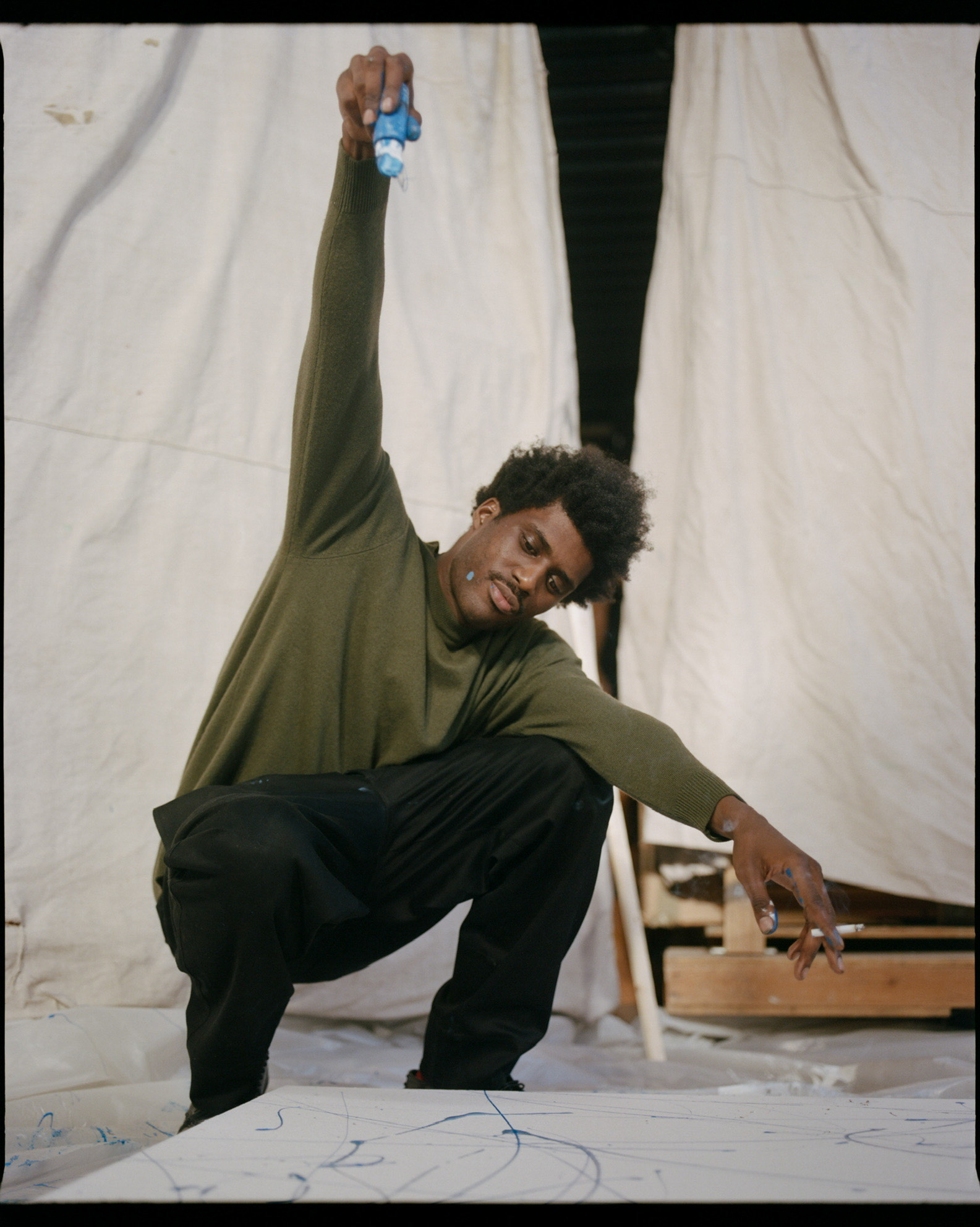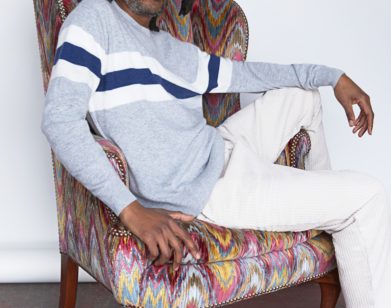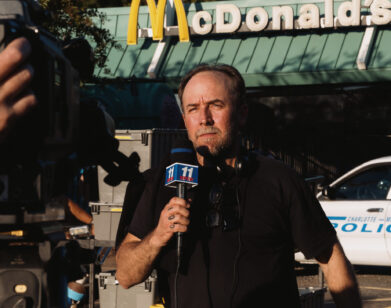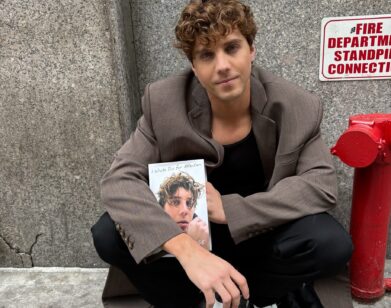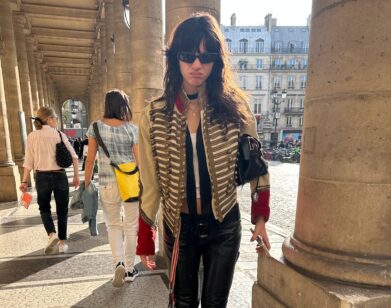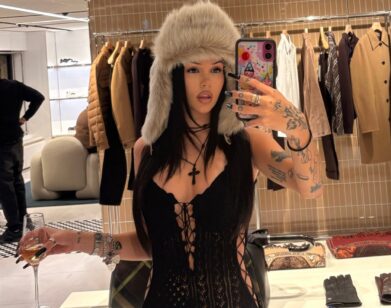in conversation
Leret Leret and Salomon Faye Deconstruct The “Mad Artist”
When the artist Salomon Faye met the Venezuelan-French cashmere designers Edouard and Andrea Leret, founders of the New York-based cashmere brand LERET LERET, “Mad Artist” was born. Their collaborative short film, which premiered today on the LERET LERET website, follows Faye—decked out in the brand’s sophisticated knitwear designs—as he furiously lathers a canvas with paint, set to a dramatic narration of one of his own poems. LERET LERET’s sumptuous cashmere silhouettes mingle with Faye’s words throughout the film’s 3-and-a-half minute runtime to create a compelling campaign for the label’s latest collection—but it also raises questions. What is a mad artist? What is the difference between madness and brilliance? We brought the founders of LERET LERET and the artist together to discuss.
___
EDOUARD LERET: Hi Salomon.
SALOMON FAYE: Hello! So, tell our audience about Leret Leret’s mission.
LERET: The idea, beyond designing sweaters, is to work with artists in all mediums. During COVID it was difficult, as a brand that wanted to work with artists, to get together and collaborate. I met Salomon here in New York City. We met like three times in the span of a week—you know when that happens? Something was just there with us energy-wise, for sure. We started hanging out and just talking.
SALOMON FAYE: Then we met at your house when I was working on the “NOT HERE” video. What was the most difficult part of working with me? What was the easiest part?
LERET: The easiest part was all the brainstorming, the back and forth of ideas, with you and I and Andrea [Leret, Edouard’s sister and the brand’s co-founder]. It was very exciting, and everything flowed. That’s what gave us the confidence to give you complete creative direction on this film. I’d say the hardest was the post-production—creating a video out of all of that raw material…how can I put this? Since you’re an artist—would you say a conceptual artist?
FAYE: Yeah, yeah.
LERET: So, you’re very careful about the work you put out there, because you care about it and that’s very valuable. I appreciate that, and I guess that was the hardest part. We had to make decisions about how to share this material, how we tag people, and so on.
FAYE: I feel that. The most difficult part for you was also the most difficult for me, but at the same time, it was my favorite part. The three of us working through those moments, figuring out how to meet in the middle, and determining what to keep and what to discard, there was a lot of growth and development in our friendship.
LERET: That’s often the hard part about working with friends—the professional line gets crossed. Andrea and I know that, because we’re family and we work together. Things get better every day, but it is hard to work with people that you’re very close to. Then again, the reward is so much sweeter at times. I enjoyed those moments with you as well.
FAYE: Beautiful clashes that then turned into a harmonious connection. How was the transition from friends to collaborators? Personally, it didn’t feel like much of a transition. When we met there was an immediate mutual appreciation. When creators become friends, you intuitively want to find a way to work together. From the jump, as our friendship was brewing, we were trying to figure out how to collaborate.
LERET: Yeah, there wasn’t much of a transition in that sense—but there was a moment when our conversations were going in all directions. That’s always nice, but acting on it is the part where people don’t always follow through. There was a moment, that made me happy and surprised, when you started behaving like a producer. You were sending pitch decks, press materials, and all that. Overnight, I went from talking to the artist, the spiritual being, to working with a producer. I was like, “Oh, okay. We’re working now.”
FAYE: [Laughs] Right.
LERET: But the chemistry was always the same, for sure. Let’s discuss the film!
FAYE: The idea of the “mad artist,” the concept for the piece, was informed by conversations Edouard and I had, just as bros sort of kicking it. When we started to zero in on the project, and the new collection came out, it became about expressing the extremes that we go back and forth from as people. The ultimate version of that is a painter. They’re the stereotypical mad artist, and as they reach the height of uniqueness and brilliance, often get lost in translation by their audience.
LERET: After the long conversations we had, the first piece of the puzzle was the poem, right?
FAYE: I would say it was probably the most integral piece of the puzzle.
LERET: The poem brought another dimension to the project. As soon as I read it, I thought you were talking about me, but I know you were talking about you, and about everybody, really, who achieve something and are misunderstood, and are not in a space where they feel comfortable. I think that’s why this is so special to me, because a lot of us feel that way. Many times in our careers they applaud you before—
FAYE: —They attack.
LERET: Before they attack. [There’s an] importance to being yourself in the face of being misunderstood by others. It’s important, as artists, that you keep pushing yourself. It’s pretty much the same in fashion. We live in a time where instant gratification is like currency, but it’s about more than that. It’s about working hard, and that gratification will come later. That’s one of the messages that I get out of this piece.
FAYE: The importance of unwaveringly being yourself in the face of being misunderstood by others.
LERET: The poem is almost an eye-opener to a feeling of anger. We get broken down so that we can be on the level of others. What do you think?
FAYE: I think one of the most important aspects of the piece was the importance of honesty. So many of us in this creative and capitalist environment are being dishonest to satisfy what’s being generally accepted. More products are being made than pieces as a result of that. What we did challenges, and even contributes to, the marriage of product and expression.
LERET: It does start off as sort of insecure. Like, “Is it okay to be mad?” It’s the journey of the mad artist. You go on to explain what will happen to you if you do open that door— your curiosity becomes delusion, your contemplation becomes depression. I love that part, because it really breaks down everything that’s going on inside this mad artist’s head. Then comes a happy ending. That, to me, is so beautiful, because I’ve had big insecurities about those things.
FAYE: That’s the bread and butter right there, because it’s not necessarily that the artist is mad, it’s that when they commit to their own truth, they are perceived that way by people who may not share their conviction.
LERET: The “mad artist” is a title given by the public.
FAYE: Absolutely. And all of us had to trust each other to allow this process to complete itself.
LERET: This project really hits home for Andrea and I, because both our parents had cashmere sweaters passed down from their parents. My dad had cashmere sweaters from his dad, and we used to wear them a lot. They have the best feel, those old sweaters. There’s just something about them that will stand the test of time. We’re trying to do less things, but better quality. It’s more about passing things on through generations—it doesn’t necessarily have to be through family, and this project shows that. The work lives on.
———
Creative Direction / Co-Director: Salomon Faye
Co-Director: Chems

